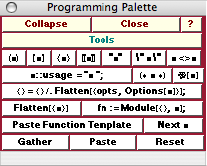|
Programming Palette
The Palette
For the buttons and executable commands that are described n this section to work it is assumed that you have installed A WorkLife FrameWork™ and have loaded it. This can be done either from the Load WorkLife Framework button on the supplied palette, by executing the command Needs["Diary`Diary`"], or by clicking on the following button:
By clicking on the on the Programming button on the All Palettes Palette you will open the Programming Palette. You can also open the Programming Palette by executing:

This Palette provides some useful buttons for writing Mathematica code.

The Programming Palette
The Palette Buttons
For the buttons and executable commands that are described n this section to work it is assumed that you have installed A WorkLife FrameWork™ and have loaded it. This can be done either from the Load WorkLife Framework button on the supplied palette, by executing the command Needs["Diary`Diary`"], or by clicking on the following button:

This set of buttons places the selected material in the InputNotebook in the indicated template which mostly consists of bracketing elements.
As examples of each, assume that the text "parameter" is selected in an input cell:

Then, respectively clicking on one of each of the buttons will would produce,








This pair of buttons places the selected material in the InputNotebook in the indicated template: the first is the template for a usage message and the second one is to create a comment.
As examples of each assume that the text "parameter" is selected in an input cell:

Then, respectively clicking on one of each of the buttons will would produce,



The last one is useful for accessing the data used by a Computation that was recently performed by the ComputationPalette:
["ComputationType"] holds the raw data of data cell of type "ComputationType" after ComputeDiaryNotebook has been executed. If ComputeDiaryNotebook is acting on multiple ComputationTypes then [{"ComputationType1","ComputationType2",...}] holds that raw data.

This button places the selected material in the InputNotebook into a template for passing an option into a function.

This pair of buttons places the selected material in the InputNotebook in the indicated template: the first Flattens the contents of a List and the second one is a template for a function definition using a Module.

The Paste Function Template button pastes a function template into the current InputNotebook at the insertion point.
The Next ■ button moves the selection to the next instance of □ in the current InputNotebook.

This set of three buttons provides an easy way for the user to accumulate a number of distinct selections from a notebook or notebooks into an internal variable.
The Reset button removes any previously accumulated items from the internal variable.
Each time the Gather button is clicked, the currently selected material in the current InputNotebook is appended to this internal list.
When the Paste button is clicked, the material in this internal list is pasted to the current insertion point in the current InputNotebook.
Copyright ©, 2005→2009 Scientific Arts, LLC. All rights reserved.
|